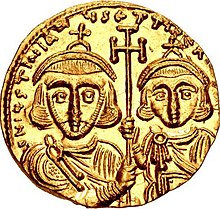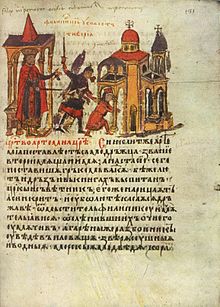Emperor of the Romans
| Tiberius | |
|---|---|
| Emperor of the Romans | |
 Solidus of Justinian with Tiberius, marked: Solidus of Justinian with Tiberius, marked:d n iustinianus et tiberi(us pp a) | |
| Byzantine co-emperor | |
| Reign | 706–711 |
| Coronation | 706 |
| Predecessor | Justinian II |
| Successor | Philippicus |
| Born | 705 Khazaria |
| Died | 711 (Aged 6) St. Mary's Church in Blachernae, Constantinople Eastern Roman Empire (now Istanbul, Turkey) |
| Dynasty | Heraclian |
| Father | Justinian II |
| Mother | Theodora of Khazaria |
Tiberius (Greek: Τιβέριος, romanized: Tibérios; 705–711), sometimes enumerated as Tiberius IV, was the son of Emperor Justinian II and Theodora of Khazaria. He served as co-emperor of the Byzantine Empire with his father Justinian II, from 706 to 711. Both were killed in 711, when Bardanes led a rebellion which marched on Constantinople. After Tiberius' death, two different individuals impersonated him, with one, named Bashir, going on to be hosted by Hisham ibn Abd al-Malik, the Umayyad caliph, before his lie was discovered and he was crucified.
History
In 705, Justinian II, who had previously been emperor of the Byzantine Empire from 685 to 695, but had been usurped by Leontius, used a vast army of Khazars, Bulgars, and Slavs to retake the throne from Tiberius III, who had in turn overthrown Leontius. While Justinian led troops into the Empire, he left his wife, Theodora of Khazaria, behind in Phanagoria, the capital of former Old Great Bulgaria, but at the time a principal city of the Khazar Empire. While there, she gave birth to Tiberius. Once Justinian had consolidated his hold on the throne, he sent for his wife and his newly born son. When they arrived in Constantinople in 706, Theodora and Tiberius were crowned augusta and augustus. In 710, when Pope Constantine visited Constantinople, he was welcomed by the Byzantine Senate and the young co-emperor Tiberius, before Constantine went on to meet Justinian II.
In 711, the Theme of Cherson rebelled against Justinian II, led by an exiled general by the name of Bardanes. The rebels resisted a counter-attack, before the forces sent to attack the rebels themselves joined the rebellion. The rebels marched on the capital, Constantinople, and proclaimed Bardanes as Emperor Philippicus. During this time, Justinian II had been traveling to Armenia, and thus did not arrive in Constantinople in time to defend it, but only after it had fallen. He was arrested, and then executed outside the city in November 711. His head was kept by Bardanes as a trophy. Upon hearing the news of his death, Anastasia, Justinian's mother, took Tiberius, at this time six years old, to St. Mary's Church in Blachernae, for sanctuary. He was pursued by men sent by Bardanes, who dragged him from the altar and murdered him outside of the church.

Two separate individuals later arose claiming to be Tiberius: one in 717/718 during the Siege of Constantinople by the Arabs; and another in 737. The second impostor, a man by the name of Bashir, plotted with a blind man named Theophantus. They arranged that Theophantus would go to Sulayman ibn Hisham, an Arab general, and son of the Umayyad caliph Hisham ibn Abd al-Malik, and inform him that he knew the location of Tiberius, who was actually Bashir himself. Sulayman believed Theophantus and instructed him to bring Bashir to him, which Theophantus agreed to do in exchange for money. Theophantus then delivered Bashir to Sulayman, whereupon Bashir denied being Tiberius profusely, so as to make Sulayman certain that he really was Tiberius. After many promises of safety and reward were given, he "confessed" that he was Tiberius. Sulayman immediately wrote to his father, Hisham, who instructed him to dress the false Tiberius in royal clothes and to have him pass through all major cities in procession. Bashir then went first to Edessa, and then the other major cities. After this, he went to Hisham, who received him with honor. Bashir stayed with Hisham, sending ambassadors to Constantinople to proclaim that Tiberius was still alive, and allied with the Umayyad. This news frightened the Byzantines, especially Emperor Leo III. However, Bashir's deception was eventually revealed, and he was crucified in Edessa.
Numismatics
Tiberius can be found on coins issued during the second reign of Justinian II (705–711). During Justinian II's first reign (686–695), the first coins to bear a depiction of Jesus Christ on the obverse were minted. During his second reign, Tiberius was featured on the reverse of the coins, alongside Justinian II. On the reverse, Tiberius and Justinian II both wear crowns, loros, and chlamys, and hold cross potents in their hands. The legend of the reverse reads: "Domini Nostri Iustinianus et Tiberius Perpetui Augusti", meaning "Our Lords Justinian and Tiberius, the Eternal Emperors".
References
Primary sources
- Kitab al-Fitan by Nu'aym ibn Hammad.
- Chronicle of 1234 by Anonymus (2.260).
- Chronicle by Theophanes.
- Chronicon Syriacum by Bar Hebraeus.
Citations
- ^ Venning & Harris 2006, p. 190.
- Crawford 2013, p. 201.
- Bellinger & Grierson 1968, p. 644.
- ^ Bury 1889, p. 361.
- ^ Haldon 2016, p. 50.
- Venning & Harris 2006, p. 192.
- De Imperatoribus Romanis.
- Norwich 1990, p. 343.
- Bury 1889, p. 365.
- Bury 1889, pp. 365–366.
- ^ Motzki 2016, p. 224.
- Hoyland 2011, p. 234.
- Curta & Holt 2016, p. 388.
- Hoyland 2011, p. 12.
- Cook 2004, p. 43.
- Green 1992, p. 92.
Bibliography
- Bellinger, Alfred Raymond; Grierson, Philip (1968). Catalogue of the Byzantine coins in the Dumbarton Oaks Collection and in the Whittemore Collection. Dumbarton Oaks. OCLC 847177622.
- Bury, J.B. (1889). A History of the Later Roman Empire from Arcadius to Irene, 395 A.D. to 800 A.D. Vol. II. MacMillan & Co. OCLC 168739195.
- Cook, Michael (2004). Studies in the Origins of Early Islamic Culture and Tradition. Ashgate Variorum. ISBN 9780860789161.
- Crawford, Peter (2013). The War of the Three Gods. Pen & Sword Military. ISBN 9781848846128.
- Curta, Florin; Holt, Andrew (2016). Great Events in Religion: An Encyclopedia of Pivotal Events in Religious History. ABC-CLIO. ISBN 9781610695664.
- Green, Tamara M. (1992). The City of the Moon God: Religious Traditions of Harran. BRILL. ISBN 9789004301429.
- Haldon, John (2016). The Empire That Would Not Die. Harvard University Press. ISBN 9780674969179.
- Hoyland, Robert G. (2011). Theophilus of Edessa's Chronicle and the Circulation of Historical Knowledge in Late Antiquity and Early Islam. Liverpool University Press. ISBN 9781846316975.
- Motzki, Harald (2016). Hadith: Origins and Developments. Routledge. ISBN 9781351931816.
- Moore, R. Scott. "De Imperatoribus Romanis". www.roman-emperors.org. Retrieved 5 January 2018.
- Norwich, John Julius (1990). Byzantium: The Early Centuries. Penguin. ISBN 0-14-011447-5.
- Venning, Timothy; Harris, Jonathan (2006). A Chronology of the Byzantine Empire. Palgrave Macmillan. ISBN 9780230505865.